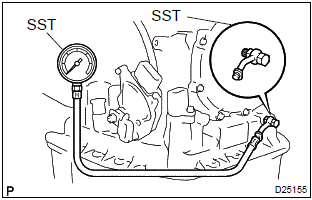Toyota Corolla (E120): Hydraulic test
1. Perform hydraulic test
- Measure the line pressure.
Notice
:
- Do the test at normal operation atf temperature 50 to 80 °c (122 to 176 °f).
- The line pressure test should always be carried out in pairs. One technician should observe the conditions of wheels or wheel stopper outside the vehicle while the other is doing the test.
- Be careful to prevent sst’s hose from interfering with the exhaust pipe.

- Warm up the atf.
- Remove the test plug on the transaxle case front left
side and connect sst.
Sst 09992–00095 (09992–00231, 09992–00271)
- fully apply the parking brake and chock the 4 wheels.
- Connect an obd ii scan tool or hand–held tester to the dlc3.
- Start the engine and check the idling speed.
- Keep your left foot pressed firmly on the brake pedal and shift into the d position.
- Measure the line pressure when the engine is idling.
- Depress the accelerator pedal all the way down.
Quickly read the highest line pressure when the engine speed reaches the stall speed.
- Do the test in the r position in the same way.
Specified line pressure:

Evaluation:
|
Problem |
Possible cause |
| If the measured values at all positions are higher |
|
| If the measured values at all positions are lower |
|
| If pressure is low in the d position only |
|
| If pressure is low in the r position only |
|
Other materials:
Setting the vehicle speed
1 Press the “ON-OFF” button to activate the cruise control.
Cruise control indicator will come on.
Press the button again to deactivate the cruise control.
2 Press the “ON-OFF” button to activate the cruise control.
Cruise control indicator will come on.
Press the button again to deac ...
Inspection procedure
Hint:
hand–held tester only:
narrowing down the trouble area is possible by performing ”a/f control” active
test (heated oxygen
sensor or other trouble areas can be distinguished). Perform active test using
hand–held tester (a/f
control).
Perform active test using the hand–held ...
Circuit description
The srs warning light is located on the combination meter.
When the srs is normal, the srs warning light lights up for approx. 6 Seconds
after the ignition switch is
turned from the lock position to on position, and then turns off automatically.
If there is a malfunction is the srs, the srs ...


